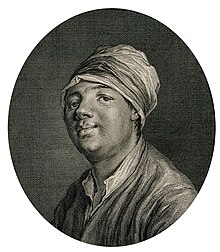Jean-Baptiste Chappe d'Auteroche
This article needs additional citations for verification. (May 2014) |
Jean-Baptiste Chappe d'Auteroche | |
|---|---|
 Jean Chappé d'Auteroche by J. B. Tilliard | |
| Born | 23 March 1722 |
| Died | 1 August 1769 (aged 47) |
| Nationality | French |
| Known for | transits of Venus |
| Scientific career | |
| Fields | astronomy |
| Institutions | Royal Academy of Sciences |
Jean-Baptiste Chappe d'Auteroche (French pronunciation: [ʒɑ̃ batist ʃap dotʁɔʃ]; 23 March 1722 – 1 August 1769) was a French astronomer, best known for his observations of the transits of Venus in 1761 and 1769.
Early life
Little is known of Chappe's early life. He was born into a distinguished family holding administrative posts and coming from
Distance from the Earth to the Sun
In the mid-18th century, the
However, transits of Venus are very rare. Before 1761, the previous transit had been in 1639; after 1769, the next transit would be in 1874. The importance of the measurement led to an unprecedented international effort to obtain as many observations as possible from different points in the world – points as far apart from one another as possible. Despite the Seven Years' War which was raging throughout most of the world, astronomers were given letters of introduction and safe passage to enable them to reach their observation points and make their observations under the coordination of the various learned societies.
Transit of Venus 1761

Chappe was chosen to go to
Chappe published an account of his travels through Russia (Voyage en Sibérie fait en 1761 (avec la description du Kamtschatka, trad. du russe de Khracheninnikow)) in 1768. The text is hardly a flattering description of the country, and an anonymous pamphlet (Antidote ou Réfutation du mauvais livre superbement imprimé intitulé : Voyage en Sibérie, etc.) was soon circulating whose authorship is often attributed to
Longitude measurement
The problem of longitude measurement had been at the heart of astronomical research for a century or more, and marine chronometers were steadily becoming more accurate. Chappe and physicist Henri-Louis Duhamel du Monceau (1700–82) were selected to test one such chronometer, made by Swiss watchmaker Ferdinand Berthoud (1727–1807) on board the corvette L'Hirondelle in 1764.
Transit of Venus 1769

For the transit of Venus on 3 June 1769, Chappe's destination was the
Legacy
As well as the contributions his observations of the
in 1996, was named in his honour.References
- ^ In memoriam (PDF), French Academy of Sciences, October 2009, archived from the original (PDF) on 2014-12-05, retrieved 2009-11-15. (in French)
- ^ a b c "Chappe d'Auteroche (Jean)", Grand dictionnaire universel du XIXe siècle, vol. 3, Paris: Pierre Larousse, 1866, p. 968. (in French)
- ^ "The Early History of Data Networks". Archived from the original on 2017-04-01. Retrieved 2014-09-24.
